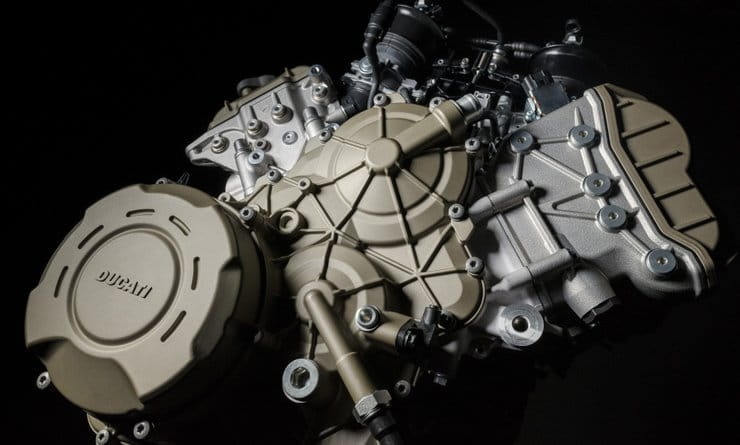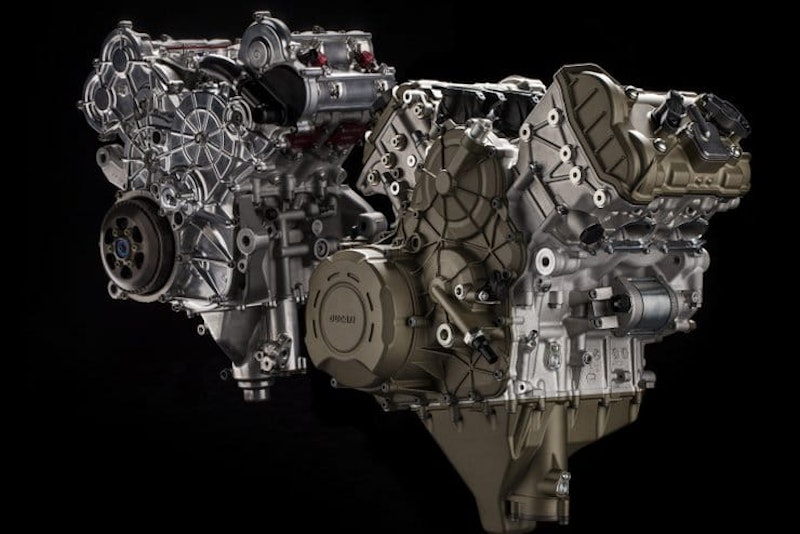Ducati Multistrada V4 in the works
By Ben Purvis
Motorcycle Journalist
16.07.2019
Ducati has already shown us the Streetfighter V4 that’s going to inherit the latest Panigale superbike engine in 2020 but the firm will also be revealing a Multistrada bearing the same V4 later this year.
Spy pictures of the bike have emerged in the print edition of German magazine Motorrad, making it clear that Ducati is busy preparing a supersized Multistrada that will be ready to take a bow in the next few months. But how much sense does it make to shoehorn a 200hp-plus MotoGP-based engine into an adventure-style tourer?
Ducati’s Panigale V4 engine is directly descended from its MotoGP unit
Of course, engine sharing has been Ducati’s modus operandi for decades. It’s a small company, making relatively few bikes each year, and engines are spectacularly expensive to develop. By spreading production across as many models as possible it’s easier to amortise the R&D costs – so the plan for a V4 Multistrada could well be one reason why the MotoGP-inspired Paniagle V4 manages to sneak in under the £20k mark despite technology and performance that could command a much higher price.
But it remains to be seen whether the V4 is well suited to a Multistrada-style tourer. In Panigale form it’s a high-revving, high-powered motor, and even with the retune that’s inevitable for use in the Multistrada it’s surely going to be a far cry from the thudding boxer twin that powers BMW’s market-dominating GS. History tells us that large, four cylinder adventure bikes struggle to make an impact on the market.
Honda’s Crosstourer: V4 adventure bikes are already out there
The only adventure bike that currently follows the V4 route is Honda’s VFR1200X Crosstourer, and despite sharing plenty of characteristics with the vastly popular BMW R1250GS – including a shaft drive as well as similar power and engine capacity – it’s never flown out of showrooms despite a tempting-looking price tag of £11,499. It’s far from certain that Honda will even opt to bring it into line with upcoming Euro 5 emissions rules.
The other notably member of the four-cylinder adventure bike gang is Kawasaki’s more road-oriented Versys 1000, and like the Honda it’s rarely mentioned as a serious rival to machines like the existing twin-cylinder Multistrada or BMW’s GS.
However, just because others haven’t managed to crack the four-cylinder adventure bike formula doesn’t mean Ducati can’t do it. The firm has a strong record of beating expectations when it comes to performance, handling and weight – just look at the Diavel to see how Ducati disproved the long-held conception that cruisers can’t be fast or handle well. In its current form, the twin-cylinder Multistrada managed a similar trick, proving that, with the right design, even adventure-style tourers can handle the occasional track day without embarrassing themselves.
Existing Multistrada 1260 is likely to coexist with the new Multistrada V4
When it comes to knowing how Ducati will repeat the same feat with the Multistrada V4 remains to be seen. Conventional thinking would suggest the firm will detune the 1103cc V4 engine, swapping some of its high-revving tendencies for more bottom-end thrust. It’s even conceivable that Ducati will increase the capacity further, because since torque tends to be closely tied to engine size and the firm is sure to want the new bike’s figures to beat the existing V-twin Multistrada. Even detuned, the V4 should easily top the 158hp of the Multistrada 1260, but that bike’s 95.5lbft of torque – coming at a relatively reachable 7500rpm – is already superior to the Panigale V4’s 91.5lbft, an the superbike needs to scream to 10,000rpm to reach its peak. A lower-revving, longer-stroke version of the V4, maybe nearer the 1300cc mark, would have numbers to beat not only the Multistrada 1260 but also anything else on the adventure bike market.
Radar-assistance is sure to be a key technology on a future Multistrada V4
Although the engine is sure to be the focus of the upcoming Multistrada V4, the bike is also likely to be among the first to benefit from Ducati’s radar-based rider-assistance technology. Last year the company announced plans to have at least one model in its 2020 range with both front and rear-facing radars. The front radar will allow the use of adaptive cruise control – with the bike automatically accelerating and braking to keep pace with the vehicle ahead – and provide warnings if the rider doesn’t notice an obstacle or slowing vehicle ahead. It could even be used to initiate emergency braking. The rear radar will provide warnings of fast-approaching vehicles behind and monitor the blind spots.
While we won’t be surprised if Ducati pulls the covers off the Multistrada V4 as its main new 2020 model at the EICMA show in Milan this November, it’s unlikely to immediately replace the V-twin Multistrada 1260. The V-twin model can remain in production in its current form until the start of 2021 without needing changes to meet Euro 5 emissions rules, and shouldn’t prove too hard to adapt to comply to those regulations if there’s demand to keep it in the range. Instead it’s more likely that the V4 version will be a range-topping adventure tourer, sitting above the Multistrada 1260 in the range and sporting a price tag somewhere north of £20,000.
Share on social media:

